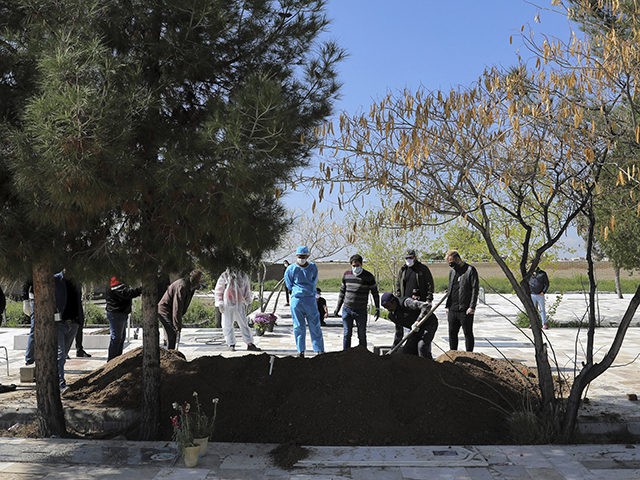The head of Tehran’s city council accused the Iranian Islamic regime of recording significantly deflated numbers of Chinese coronavirus cases nationwide on Sunday, the latest official to question Ayatollah Ali Khamenei’s health ministry response to the pandemic.
City Council Chairman Mohsen Hashemi accused the national Health Ministry of refusing to count deaths prior to Khamenei admitting that doctors had documented the presence of the virus, which originated in the central Chinese city of Wuhan, in the country. He cited unnamed “experts” in documenting cases in Tehran.
“A delay in announcing the start of the outbreak in Iran, not taking into account the number of those who died before the announcement, lack of adequate test equipment,” Hashemi listed, according to Radio Farda, “and presenting COVID-19 [Chinese coronavirus] deaths as respiratory problems cases are among the reasons why the figures announced by the Health Ministry are much lower than actual numbers.”
Hashemi reportedly concluded that the “actual numbers are several times higher than what is being announced by the government.”
The national Health Ministry has not released official data for Tehran and Qom, the city where the virus first arrived from China, likely as a result of its status as a holy city in Islam. Hashemi also reportedly demanded a reversal of this policy.
Iran officially claims to have documented 83,505 cases of Chinese coronavirus nationwide and 5,209 deaths. Hashemi joins a growing chorus of local officials who have cast doubt on the official statistics, in part by noting that adding up the number of cases and deaths reported by the most affected cities yield significantly more cases than the total the Health Ministry reports regularly. The Iranian dissident group the National Council of Resistance of Iran (NCRI) has been using sources on the ground since the outbreak in the country began to keep its own, separate tally of coronavirus deaths and found on Sunday that the real death toll is likely as much as six times higher than official estimates.
As of April 19, the NCRI claims to have confirmed 32,200 deaths nationwide. Unlike the Iranian regime, the NCRI has posted numbers from Iran and Qom, estimating that the death toll in Tehran is 5,350 people, higher than Iran’s claimed national death toll. In Qom, NCRI has documented 2,990 deaths.
NCRI translated more of Hashemi’s remarks from Sunday’s meeting, reporting that he expressed concern on the part of the entire city council regarding “the normalization of the coronavirus situation based on the official stats provided by the Health Ministry. Regretfully, these concerns have not been met with kind responses by the spokesperson of the Health Ministry.”
“The assessment of the Parliamentary Research Center and the opinion of experts indicate that the country’s coronavirus cases are much more numerous than the officially declared figure,” NCRI quoted Hashemi as saying. “The difference is due to different factors, including delays in declaring the start of the coronavirus outbreak and not calculating prior cases, insufficient testing and declaring other types of diseases such as respiratory disease and corona-like illness.”
Local officials have not been alone in questioning Tehran. One Health Ministry spokesman, Kianush Jahanpur, has repeatedly cast doubt not only on Iran’s official coronavirus statistics, but on those of close ally China. In late March, Jahanpur revealed that “every 10 minutes one person dies from the coronavirus and some 50 people become infected with the virus every hour in Iran,” an unsustainable death rate if the official statistics from his ministry were correct. Jahanpur had previously criticized the Islamic Revolutionary Guard Corps (IRGC), a terrorist wing of the Iranian military tasked with nationwide coronavirus response, for holding a funeral for one of its members that attracted thousands of people.
As for China’s statistics, widely derided in the free world as impossibly low given the number of sets of remains at funeral homes in affected areas like Wuhan, Jahanpur called them a “bitter joke” in early April.
Iran also appeared to have allowed several media outlets to question its numbers before officials at the Health Ministry attacked China, a pivot in its coronavirus response.
For the most part, the national response to coronavirus has been in the hands of the IRGC. Despite being a U.S.-designated terrorist organization typically tasked with repressing dissidents and acts of terrorism in neighboring countries, the Islamic regime claimed that the IRGC was working on a vaccine against the Chinese coronavirus in the early days of the outbreak. Last week, the commander of the IRGC, Hossein Salami, claimed the terrorist group had created a “”magnetic bipolar coronavirus remote detector,” the first device of its kind in the world to identify viruses. Observers noted that the device featured in state media appeared to be a fake device previously sold as a scam to detect bombs.
The Iranian government also fought the Chinese coronavirus by holding a cartoon contest that received several anti-semitic submissions. Iranian officials have called the virus a “Zionist” weapon.
Last week, Tehran officials revealed that they had begun digging mass graves for 10,000 people, double the number of people the Islamic regime claimed had died of the virus in the entire country.

COMMENTS
Please let us know if you're having issues with commenting.